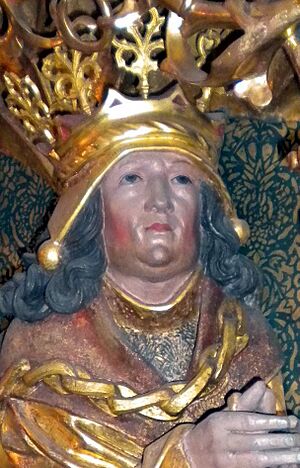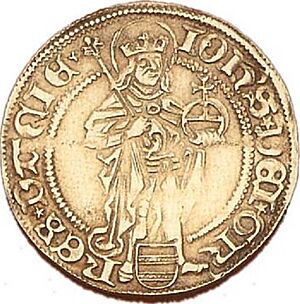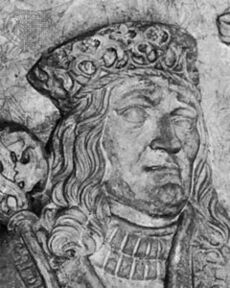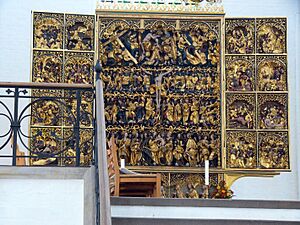John, King of Denmark facts for kids
Quick facts for kids John |
|
|---|---|

|
|
| King of Denmark (more...) | |
| Reign | 21 May 1481 – 20 February 1513 |
| Coronation | 18 May 1483 Church of Our Lady, Copenhagen |
| Predecessor | Christian I |
| Successor | Christian II |
| King of Norway (more...) | |
| Reign | 1483 – 20 February 1513 |
| Coronation | 20 July 1483 Nidaros Cathedral |
| Predecessor | Christian I |
| Successor | Christian II |
| King of Sweden (more...) | |
| Reign | 6 October 1497 – August 1501 |
| Coronation | 26 November 1497, Stockholm |
| Predecessor | Charles VIII |
| Successor | Christian II |
| Born | 2 February 1455 Aalborghus Castle, Aalborg |
| Died | 20 February 1513 (aged 58) Aalborghus Castle, Aalborg |
| Burial | St. Canute's Cathedral, Odense (from 1807) |
| Spouse |
Christina of Saxony
(m. 1478) |
| Issue among others... |
Christian II Elizabeth, Electress of Brandenburg Francis Jacob the Dacian (probably) |
| House | Oldenburg |
| Father | Christian I of Denmark |
| Mother | Dorothea of Brandenburg |
| Religion | Roman Catholic |
John (born Johannes) was a powerful king who ruled over Denmark, Norway, and Sweden. He was part of the Kalmar Union, which was a union of these three kingdoms. John was King of Denmark from 1481 to 1513, King of Norway from 1483 to 1513, and King of Sweden (as John II) from 1497 to 1501. He also ruled as Duke of Schleswig and Holstein with his brother Frederick.
King John had three main goals during his reign. He wanted to bring the Kalmar Union back together. He also aimed to reduce the power of the Hanseatic League, which was a strong group of trading cities. Finally, he worked to build a strong royal power for Denmark.
Contents
Biography of King John
Early Life and Family
John was born on February 2, 1455, at Aalborghus Castle in Aalborg, Denmark. His father was Christian I of Denmark, and his mother was Dorothea of Brandenburg. John was their third son, but the oldest to survive childhood.
In 1478, John married Christina of Saxony. They had several children together, including Christian II, Francis, and Elisabeth. Elisabeth later became a princess in Brandenburg.
Becoming King
John's father, King Christian I, had arranged for John to be the next king of Norway and Denmark. In 1467, John was officially named the future king of Denmark. When his father died in 1481, John became king of Denmark without any problems.
However, in Norway, things were a bit different. The Norwegian Council wanted to show that Norway was an independent kingdom. They didn't immediately accept John as king. After some discussions, the Danish and Norwegian councils agreed on the terms for John's rule. He was crowned King of Denmark in Copenhagen on May 18, 1483, and King of Norway in Trondheim on July 20, 1483. The Swedish Council did not attend this meeting, so Sweden did not accept him as king at this time.
Ruling the Kingdoms
In the early years of his rule, King John used diplomacy to try and weaken the position of Sten Sture the Elder, who was the regent of Sweden. He also looked for new allies, even forming a political partnership with Russia. In 1493, Russia made a treaty with Denmark and later stopped Hanseatic merchants from trading in Novgorod. This caused problems for the Hanseatic cities.
King John also focused on improving Denmark's economy. He supported Danish merchants and often chose common people, rather than just nobles, to be officials and advisors. This made some of the nobility unhappy. One of his most important achievements was creating a permanent Danish navy. This navy became very important later in his reign.
The duchies of Schleswig and Holstein were supposed to elect a duke from the previous duke's sons. Many nobles wanted John's younger brother, Frederick, to be the sole duke. However, John successfully argued that both he and Frederick should be co-dukes. In 1490, when Frederick became an adult, the duchies were divided between them.
Reuniting the Kalmar Union
King John's main goal was to reunite the Nordic countries under his rule. In June 1495, he sailed with his fleet to Kalmar, Sweden, hoping to meet with the Swedish Council. His flagship, the Gribshunden, exploded and sank near Ronneby, but John was not on board. He continued his journey, but Sten Sture kept delaying their meeting. John eventually gave up and returned to Copenhagen.
After this, John decided to use military force. On October 6, 1497, he successfully conquered Sweden in a quick military campaign. He defeated Sten Sture and won over most of the Swedish nobility. John was crowned King of Sweden, and Sten Sture was given a high position of power under the King.
Challenges and Later Years
In 1500, King John tried to conquer Dithmarschen, an area in today's Schleswig-Holstein. The people of Dithmarschen were independent farmers. John launched a large campaign with his brother Frederick. However, the Ditmarsians, led by Wulf Isebrand, tricked John's army. They opened the dikes and flooded the narrow main road, trapping many soldiers at the Battle of Hemmingstedt. This defeat on February 17, 1500, greatly hurt John's reputation.
In 1501, Sweden decided they no longer wanted John as their king. John then fought a long and difficult war against Sten Sture and his successor, Svante Nilsson. This conflict also caused problems with the Danish nobility and the Hanseatic cities, especially Lübeck. In 1509, Sweden agreed in principle that John was their king, but he was never allowed to enter Stockholm again or be crowned king of Sweden.
Meanwhile, John's son, Prince Christian (who later became King Christian II), helped control any opposition in Norway. He was the viceroy of Norway from 1506 until he became king in 1513. Between 1510 and 1512, King John fought a final war against Sweden and Lübeck. Denmark faced difficulties at first, but with the help of Scottish sailors, they managed to turn the tide with a strong naval attack. The war ended with no major changes for Sweden, but Lübeck suffered a significant political and economic setback.
King John was often seen as a "commoner's king" because he was friendly and down-to-earth. However, he was also a very realistic and clever politician. He was similar to other strong kings of his time, like Louis XI of France and Henry VII of England.
Death and Burial
King John died on February 20, 1513, at Aalborghus Castle. He passed away shortly after falling from his horse. He was first buried in the church of the Franciscan friary in Odense.
Queen Christina, his wife, later lived in a nunnery in Odense. She asked the famous German sculptor Claus Berg to create a beautiful burial chapel. Both she and King John were laid to rest there after her death in 1521. The late Gothic altarpiece carved by Berg between 1515 and 1525 is a national treasure of Denmark. It has intricate carvings and is gilded with gold. It survived the Protestant Reformation because of its connection to the royal burials. King Christian II, the son of King John and Queen Christina, was also buried in this royal chapel with his wife.
In 1807, the old Franciscan church was taken down. Berg's altarpiece and the six royal bodies were then moved to St. Canute's Cathedral, also in Odense.
Succession to the Throne
John's 32-year-old son, Christian II of Denmark, became the next king. However, Christian II was removed from the throne in 1523. King John's family line eventually returned to the Danish and Norwegian thrones through his daughter, Electress Elisabeth. Her great-great-grandson, Christian IV of Denmark, became king.
Full Royal Title
King John's full title as King of Denmark, Sweden, and Norway was: King of Denmark, Sweden, Norway, the Wends and the Goths, Duke of Schleswig, Holstein, Stormarn and Dithmarschen, Count of Oldenburg and Delmenhorst.
Children of King John
King John and Queen Christina had five or six children:
| Name | Birth | Death | Notes |
|---|---|---|---|
| Hans | 1479 | 1480 | Died as a baby |
| Ernst | 1480 | 1480 | Died as a baby |
| Christian II | 1 July 1481 | 25 January 1559 | Became King of Denmark, Norway, and Sweden. He had children. |
| Jacob | 1484 | 1566 | Likely Jacob the Dacian |
| Elizabeth | 24 June 1485 | 10 June 1555 | Married Joachim I Nestor, Elector of Brandenburg in 1502. She had children. |
| Francis | 15 July 1497 | 1 April 1511 |
See also
 In Spanish: Juan I de Dinamarca para niños
In Spanish: Juan I de Dinamarca para niños
- List of Danish monarchs
- List of Norwegian monarchs
- List of Swedish monarchs
- Danish monarch's family tree





